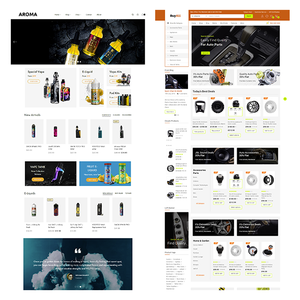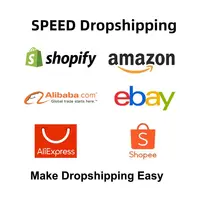








































 Ready to Ship
Ready to Ship





































































































































































Top categories
About online dropship store
In the digital age, the allure of e-commerce beckons entrepreneurs to the dropshipping realm, a business model celebrated for its low overhead and potential for profitability. But the key to unlocking this potential lies in the strategic sourcing of inventory for your online dropship store. This guide illuminates the path to profit maximization, from understanding the intricacies of dropshipping to leveraging the colossal marketplace of our platform. It offers a deep dive into selecting the right products, evaluating trustworthy suppliers, and mastering the art of negotiation and cost management. With a focus on quality control, branding, and scaling, this article is your compass to navigate the competitive seas of online retail and emerge with a thriving, profit-generating dropship business.
Understanding Dropshipping and Its Profit Potential

Dropshipping is a business model where the seller does not keep products in stock but instead transfers customer orders to a supplier, who then ships the goods directly to the customer. This model allows for a reduction in overhead costs since there is no need to invest in inventory or warehousing. Despite traditionally low margins, dropshipping can be quite profitable when done correctly.
Profitability in dropshipping hinges on several factors, including the ability to source products at a competitive price, effective marketing strategies to drive sales, and the selection of a niche with sufficient demand but not oversaturated with competitors. Understanding the nuances of markup versus margin is crucial for pricing products in a way that ensures profitability.
Successful dropshippers often employ strategies such as focusing on niche markets, investing in marketing and the right software tools, and tracking key performance indicators to make informed decisions. Additionally, exploring different supplier options to maximize margins, known as drop surfing, can also contribute to a dropshipping business's success.
The potential earnings from dropshipping can vary widely, with some dropshippers making significant profits. The key to maximizing revenue is finding a balance between product pricing and market demand, which involves careful demand planning and possibly diversifying income streams through methods like affiliate marketing.
The Role of Our Platform in Dropshipping

Our platform plays a pivotal role in the dropshipping landscape, offering a vast marketplace for businesses to source products. Unlike other platforms that cater to small-scale purchases, ours is designed for businesses seeking to buy in bulk. However, it has adapted to the dropshipping model by allowing the purchase of single units from certain suppliers.
Dropshipping with us involves more complexity than platforms geared specifically towards dropshipping due to its focus on wholesale transactions. Despite this, it presents a unique opportunity for businesses to differentiate their offerings with products not readily available on other dropshipping platforms.
The platform's massive scale means that virtually any product type can be sourced, making it a valuable resource for dropshippers looking to expand their product range. While traditionally used for larger orders, the growing trend of suppliers open to dropshipping allows businesses to leverage our extensive network for their dropship stores.
Finding a dropshipping partner on our platform requires careful vetting of suppliers to ensure reliability and trustworthiness. The platform offers various tools and features to aid in this process, such as Trade Assurance, which can filter suppliers more likely to accommodate dropshipping needs.
Selecting the Right Products for Your Store
Selecting the right products is a cornerstone of a successful dropshipping business. Products that tend to sell well often tap into impulse buying, driven by attractive ads and competitive pricing. While anything can potentially sell with the right marketing, certain strategies can increase the likelihood of success. It's beneficial to look for niches with low competition yet high search volumes, or to capitalize on trending items that are currently popular. For dropshipping, a mix of niche products and trending items can create a balanced and dynamic inventory for your store.
When considering what to dropship, it's important to understand the types of products that resonate with consumers. For instance, categories such as women's clothing, baby products, tools, and car accessories have shown profitability in the dropshipping market. These niches not only have a significant search presence but also a wide array of products to choose from. By focusing on these areas, you can cater to specific consumer needs and trends, which can help in establishing a loyal customer base.
To further refine your product selection, delve into sub-niches and assess the potential of individual items. For example, within women's clothing, knitted dresses have emerged as a comfortable and trendy choice. Similarly, in technology, items like ring lights have become indispensable for content creators, and wireless security devices are gaining traction due to increasing interest in home security. By identifying products that are not only in demand but also have a proven track record, you can curate a compelling inventory for your dropshipping store.
Evaluating Suppliers on Our Platform
When considering suppliers on our platform for your dropshipping business, it's essential to understand the value of choosing Assessed Suppliers. These suppliers have undergone a verification process to ensure they meet a standard of reliability and trustworthiness. The verification process includes an assessment of various aspects of the supplier's business, from company profiles and manufacturing capabilities to product quality and certifications. This thorough evaluation is designed to give you a clearer picture of the supplier's business operations and product offerings.
The information verified during this process is comprehensive. It covers the legal status of the company, its physical presence, and the authenticity of its industrial certifications. This is crucial for dropshippers who rely on suppliers to provide products that meet certain standards and regulations. By selecting Assessed Suppliers, you're more likely to engage with entities that have a proven track record and are recognized for their operational integrity.
Understanding the verification process itself can also be beneficial. It typically involves on-site checks and an in-depth review of the supplier's legal and operational documents. This process is intended to ensure that the supplier can consistently meet the demands of a dropshipping business, which requires a steady supply of products, reliable production capabilities, and the ability to uphold product quality over time.
Negotiating Deals and Managing Costs
In the realm of dropshipping, managing shipping costs is a critical aspect of negotiating deals and maintaining profitability. A strategic approach to handling these costs involves several methods. One effective strategy is to incorporate shipping fees into product pricing, allowing for transparent cost communication to customers. This method ensures that customers are aware of the total price upfront, eliminating concerns about hidden fees during checkout.
Another tactic is to implement a single flat shipping rate. This can be calculated by forecasting the expected number of orders and dividing the total shipping fees by this number, thus determining a flat rate that covers shipping costs without impacting profit margins.
Tiered flat rates offer an alternative, setting shipping costs based on the price or weight of the order. This approach can pass on savings from the supplier to the customers, especially when the supplier charges less for shipping additional items.
Per-item shipping rates can also be applied, particularly when suppliers charge a flat fee for each product. This method ensures that shipping costs remain accurate and prevents profit loss on larger orders. However, it's important to consider the complexity that may arise when orders contain products with different shipping profiles, potentially leading to higher shipping costs for customers.
Ultimately, the choice of shipping strategy should be informed by the supplier's shipping fees, the nature of the products sold, and the preferences of the target market. Regularly reviewing and adjusting these strategies is essential as the business scales and shipping dynamics change.
Leveraging Features for Maximum Efficiency

The platform offers a diverse range of dropshipping tools that cater to various business needs, enabling store owners to streamline their operations. The selection includes multi-functional kitchen tools, which combine several kitchen gadgets into one, saving space and cost. For those in the DIY niche, there are comprehensive hand tool kits in trolley cases, providing a portable solution for maintenance tasks. The platform also caters to specialized needs with items like tactical folding knives and gardening tool sets, which appeal to outdoor enthusiasts and gardeners, respectively.
The platform's dropshipping-friendly items, such as stainless steel fruit and vegetable peelers, demonstrate the ease with which one can offer products that are in demand and ready to ship. This is crucial for maintaining efficiency in inventory management and order fulfillment. Additionally, the array of dropshipping tools extends to car maintenance with products like windscreen polishing kits, indicating the breadth of niches that online store owners can serve.
For entrepreneurs looking to cater to the culinary market, the platform provides a variety of kitchen gadgets, including multifunctional vegetable cutters and dumpling molds, which are practical and popular among cooking enthusiasts. These products are not only functional but also designed to enhance the user experience, making them attractive for dropshipping stores aiming to offer value to their customers.
Quality Control and Branding
In the realm of dropshipping, the significance of product quality control cannot be overstated. It is a foundational aspect of eCommerce that directly impacts customer satisfaction and, consequently, the success of your online store. A robust quality control system involves several key steps to ensure that products meet certain standards. Initially, it's crucial to partner with factories that have established certification standards, ensuring that production efficiency and reliability are up to par. Each product must align with the client's specifications, a process that begins with a thorough inspection upon arrival at the fulfillment centers.
The commitment to quality extends to the packaging process, which is meticulously reviewed before products are dispatched to customers. This attention to detail in quality control is not merely an option but a fundamental process that precedes all others, including the final inspection. By focusing on delivering products that meet these rigorous standards, your dropshipping business is positioned to garner positive reviews, fostering trust and encouraging repeat business. The operational aspects, from quality checks to the final shipment, are handled with precision, allowing you to concentrate on refining your marketing strategies and scaling your business.
Scaling Your Dropship Business
To scale your dropshipping business effectively, it's essential to adopt a strategic approach. Branding is a critical first step; creating a unique identity for your business can set you apart in the market. Understanding your customers deeply allows you to tailor your offerings and marketing strategies to meet their needs. Automation and outsourcing are key to managing increased demand efficiently, enabling you to focus on core business growth activities.
Investing in customer support is crucial as it directly impacts customer satisfaction and retention. Marketing your business is also vital; an effective marketing strategy can attract new customers and increase sales. Lastly, reducing costs where possible without compromising on the essentials can help maintain profitability as you expand. These practices are fundamental to growing your dropshipping business and achieving long-term success.
Conclusion
Navigating the dropshipping industry requires more than just a keen eye for trending products; it demands a strategic approach to sourcing, branding, and scaling. Throughout this guide, we've explored the critical elements that contribute to a successful dropship business, from leveraging the vast marketplace to meticulously selecting products that resonate with consumers. We've underscored the importance of partnering with Assessed Suppliers for quality assurance and highlighted negotiation tactics that preserve profitability. Furthermore, we've emphasized the significance of quality control and the power of branding in establishing a reputable online presence. As you apply these insights to scale your business, remember that consistent quality, customer satisfaction, and adaptability are the cornerstones of growth. By integrating these principles, your dropshipping venture is well-positioned to thrive in the dynamic e-commerce landscape, turning potential into profits.

























